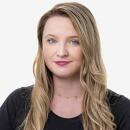Inflation brings California food banks a surge in first-time users on ‘razor’s edge’

- Share via
SACRAMENTO — More than a dozen people stood in the rain last week before the gates at the Sacramento Food Bank & Family Services distribution center had even opened. Parked cars wrapped around the block.
“Our walkup line is growing. We’re hearing from people that they don’t want to waste their gas sitting in the drive-through line while waiting for their boxes,” said spokesperson Kevin Buffalino. “People are on that razor’s edge right now, and the cost of gas is eating into their food budgets.”
Food banks across the state are seeing an influx of new faces as spikes in the cost of groceries and gas have some Californians seeking help for the first time. The numbers of those receiving services dipped at the start of the year as the spread of the COVID-19 virus waned, but are now rising in the face of the highest inflation in 41 years.
The issue is twofold, as food bank administrators are grappling with their own higher costs for food and the gas it takes to transport it to local pantries. In December, Sacramento Food Bank & Family Services paid a wholesale price of 93 cents per dozen for eggs. Last week, it paid $2.20 per dozen.
The California Assn. of Food Banks is calling for nearly twice as much money from the state than Gov. Gavin Newsom proposed in his January budget for the regional organizations, warning that relief from the government that had buoyed low-income families during the pandemic is expiring and will further contribute to financial woes.
“What we’re looking at is several elements of what we call a food cliff, all colliding at the same time,” said Becky Silva, the association’s senior policy advocate. “The national discourse is that the pandemic is ending, but we know the hardships associated with it, and its impact on families’ economic status, is continuing. Hunger is actually getting worse as these federal provisions that are meant to help people are starting to go away. It’s too soon for us to stop supporting people.”
Antipoverty groups were on edge as the federal public health emergency was set to expire on April 16, meaning the end of a slew of pandemic relief efforts including extra food benefits — a change that food banks warned would push more people to their services. The Biden administration ultimately extended the emergency status an additional 90 days.
The Food Bank of Santa Barbara County has seen a 30% increase since the final three months of last year in both pounds of food distributed and clients served. Administrators pointed to inflation and the end of federal child tax credit deposits as primary reasons for the recent increase in demand.
Earlier this month, the organization gave a cost-of-living raise to some of its employees as gas prices soared. The average cost of gas in California now stands at $5.70, according to AAA, the highest in the nation.
“Inflation is the major issue. We saw our numbers begin to trail off and we thought, ‘Great, we’re getting over COVID.’ Now we’re up again,” said Santa Barbara Food Bank CEO Erik Talkin. “Food and gas are significant for individual people — if you’re a low-income family then you spend a big chunk of your money on those two things that are the hardest hit. But it’s also highly significant for the food bank. We’re spending a lot of money on the logistics of moving food around.”
Sacramento Food Bank & Family Services has seen a 40% increase in people served in the past month.
“The recent uptick in numbers further exposes the need for these resources from the state as we move forward,” spokesperson Buffalino said.
Mildred English was among those standing in the rain in Sacramento last week and went home with bags of apples, squash, potatoes and frozen fish sticks. The food bank served 653 families at a distribution event last Thursday.
For English, it’s the recent spike in the price of blueberries — now $6.99 at the nearest Safeway — that shocked her the most, a sign that her grocery list would need to be pared down.
“It makes a big difference. It fills in for things that I can’t buy at the grocery store,” English, who is retired, said of the food bank, which she uses sporadically depending on her budget. “I’m just by myself, and it makes the difference. I can’t imagine having kids to feed.”
Twenty percent of Californians face food insecurity on a daily basis, according to the Northwestern University Institute for Policy Research, which tracks data weekly based on U.S. Census surveys.
While the California Assn. of Food Banks praised anti-hunger programs implemented by Newsom, including free universal school meals and a proposal to expand food benefits to older adults regardless of immigration status, food banks serve a specific purpose and need specific support, they said.
Newsom is proposing a one-time boost of $50 million for food banks in the fiscal year that begins on July 1, in addition to the annual $8 million the state has provided in base funding in recent years. Early reports of April tax payments show the state could end up with a cash surplus by next summer even larger than the $30 billion predicted by some analysts.
The association says that California food banks need at least $120 million from the state this year and $60 million in permanent ongoing funding after that.
The governor’s advisors point to various previous investments in food banks, including $125 million in federal funds and $30 million from the state for COVID-19 support in the 2020-21 budget, plus an additional $110 million from the state in the current fiscal year.
Food banks often ask no questions, a significant benefit to families that financially struggle but do not qualify for safety net programs like CalFresh. And the services are critical in a place like California, where housing costs continue to consume a disproportionate share of budgets, said Lauren Lathan Reid, spokesperson for the California Assn. of Food Banks.
“We know recovery from these sorts of economic downturns takes years and years. At the same time, we’re hearing food banks may have doubled the amount of food they’re distributing in their communities,” she said. “We need an appropriate state response to the demand we’re seeing.”
More to Read
Sign up for Essential California
The most important California stories and recommendations in your inbox every morning.
You may occasionally receive promotional content from the Los Angeles Times.











